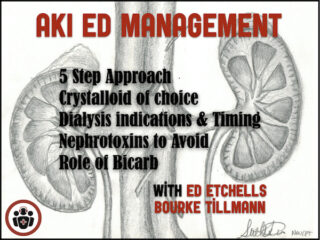
Ep 154: 4-Step Approach to Bradycardia and Bradydysrhythmias
How do we figure out when bradycardia is due to a medical illness and when it is a primary cardiac problem? What are the 4 immediate life threatening diagnosis that we have to entertain and address in the first few minutes of the sick bradycardic patients? What are some key ECG patterns that are sometimes missed by ED docs that can have devastating consequences? How can we better understand Torsades de Pointes by understanding AV blocks? How can we better understand Mobitz l and ll using 'The Dorian' approach? What is BRASH syndrome and how can we recognize it? In this main episode podcast 4-step Approach to Bradycardia and Bradydysrhythmias with electrophysiologist, educator and researcher Dr. Paul Dorian and Chair of Education for the ED at Cook County Hospital Dr. Tarlan Hedayati, we dig deep into bradycardia...
Ep 153 Pediatric Minor Head Injury and Concussion
Recent literature suggests that pediatric patients take longer to recover from mild traumatic brain injury compared to adults, and persistent post-concussive symptoms (PPCS) after 1 month occur in up to 30% of children after minor head injury. These children can and should be identified in the ED based on the PPCS clinical risk score. In this EM Cases main episode podcast "Pediatric Minor Head Injury and Concussion" Dr. Sarah Reid and Dr. Roger Zemek discuss how best to incorporate the PECARN and CRASH2 decision tools into your practice, the role of Fast MRI, how to identify children who are at risk for long term sequelae after a minor head injury and how to manage persistent concussion symptoms when a child returns to the ED after a minor head injury...
Ep 152 The 7 Ts of Massive Hemorrhage Protocols
Dr. Jeannie Callum, Dr. Andrew Petrosoniak and Dr. Barbara Haas join Anton in answering the questions: How do you decide when to activate the MHP? How do you know when it is safe to terminate the MHP? What lab tests need to be done, how often, and how should the results be shared with the clinical team? Once the dust settles, what do we need to tell the patient and/or their family about the consequences of being massively transfused? What should be the lab resuscitation targets? Why is serum calcium important to draw in the ED for the patient who is exsanguinating? How do we mitigate the risk of hypothermia? What can hospitals do to mitigate blood wastage? If someone is on anti-platelets or anticoagulants what is the best strategy to ensure the docs in the ED know what to give and how much? Until the results of lab testing come back and hemorrhage pace is slowed, what ratio of plasma to RBCs should we target? What's better, 1:1:1 or 2:1:1? Should we ever consider using Recombinant Factor 7a? If the fibrinogen is low, what is the optimal product and threshold for replacement? When and how much TXA? Anyone you wouldn’t give it to? and many more...
Ep 151 AKI Part 2 – ED Management
In this Part 2 of our AKI series we discuss the timing, volume and IV crystalloid of choice in AKI patients as well as dialysis indications and timing in light of the recent STARRT-AKI trial. We answer the questions: are piperacillin and vancomycin in combination contraindicated in patients with severe AKI? Is vasopressin preferred over norepinephrine in patients with AKI and septic shock? Is there a role for IV sodium bicarbonate in AKI? When should ACEi/ARBs be held in AKI patients? When, if ever, should NSAIDs be given in AKI patients, and if so, how should the dose be modified? and many more....
Ep 150 Acute Kidney Injury – A Simple Emergency Approach to AKI
In this first part of our 2 part podcast series on AKI we answer questions such as: Is there any value in the BUN:Cr ratio in distinguishing prerenal from intrarenal disease? Why is nephritic syndrome one of the most important intrarenal causes to pick up in the ED? Is there any value in urine electrolytes for the ED workup of AKI? Is there a role for bicarb in patients with severe AKI? How can we choose wisely when it comes to imaging for patients with AKI? How can we utilize POCUS best in working up the patient with AKI? What are the indications for ordering a CK to look for rhabdomyolysis? At what CK level do patients typically develop AKI? How can the McMahon score help us manage rhabdomyolysis? What is the value of urine myoglobin in the workup of rhabdomyolysis? What are indications for dialysis in patients with rhabdomyolysis? What are safe discharge criteria for patients with rhabdomyolysis? and many more...
Ep 149 Liver Emergencies: Thrombosis and Bleeding, Portal Vein Thrombosis, SBP, Paracentesis Tips and Tricks
In this part 2 of our 2 part series on Liver Emergencies we clear up the confusing balance between thrombosis and bleeding in liver patients, the elusive diagnosis of portal vein thrombosis, spontaneous bacterial peritonitis diagnosis and treatment and some tips and tricks on paracentesis with Walter Himmel and Brian Steinhart....







